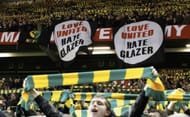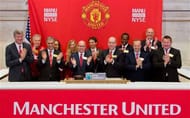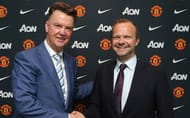Twenty league titles, three European Cups, eleven FA Cups. These are just some of the reasons Manchester United are currently the biggest club in England. Until five years ago, the argument could be made that they were the biggest in the world, but that title probably goes to Real Madrid for the time being, and only because they seem to be able to attract United’s best players at will.
United certainly aren’t far behind though, as their spending spree in the summer of 2014 proved. Players such as Angel Di Maria, Radamel Falcao, Ander Herrera and Daley Blind arrived at Old Trafford in what was the second largest transfer spending spree in football ever (€196 million, only lower than Real Madrid’s (them again!) purchases in 2009, which saw the arrivals of Cristiano Ronaldo and Kaká, among others).
What makes this impressive is that for most of their history, Manchester United were never the domestic force (albeit the best-supported club) that Real Madrid were, until the 1990s. United’s meteoric rise is a relatively new one, catalysed largely due to their success in that decade.
The presence of a dominant squad on the football pitch was joined with a massive TV deal for the whole league (the beginning of the Premier League era), and it was the combination of these two factors that really provided the base for United to begin their domestic and global domination.
May 2015 marked the 10-year anniversary of the ownership of United by the Glazer family, a move that changed the way football clubs are owned and operated. The Glazers presided over huge levels of debt but also created a structure that massively increased revenues across the board, paving the way for United’s financial dominance in the years to come.
The Glazer takeover
The explosion of the Premier League led to unprecedented windfalls in English football. Manchester United tried to take advantage of this and listed themselves publicly on the London Stock exchange, in addition to various other money-generating schemes across the world.
The public listing of the holding company meant that two Irish businessmen, who were heavily involved in horse-racing (John Magnier and J.P McManus) gradually became the largest shareholders via their company, Cubic Expression.
Sir Alex Ferguson owned a stake in Rock of Gibraltar, a famous horse that Magnier’s wife also had a stake in. Controversy then ensued over the exact ownership of the horse, with the dispute finally being settled out of court. Magnier and McManus tried to have Ferguson fired, and the club’s board of directors responded by seeking investors to buy out the 28.7% stake held by the two Irishmen in the club.
The Glazer family first became involved with Manchester United in March 2003, spending around £9 million on a 3% stake in the club through their holding company, Red Football. The Glazers steadily kept buying shares of the club, owning 15% by November that year and triggering talks of a takeover bid. By October 2004, their ownership in the club had reached nearly 30%, which would trigger a takeover bid, according to UK takeover law.
In May 2005, an agreement for the acquisition of Magnier and McManus’ 28.7% stake had been reached, taking their stake to 57%. The Glazers continued to buy out the remaining shareholders. In May 2005, their ownership reached 75%, and gave the Glazers had the option to delist the holding company from the London Stock Exchange, which they subsequently did in June of that year, making it the first time in 14 years that the club wasn’t publicly traded. The takeover was completed by the end of June, with the club being valued at £790 million.
Debt, fan protests, and refinancing
Most of the Glazer takeover was financed by various instruments of debt. The total debt was split between the Glazer family and the club itself, with around £275 million being secured against the club’s assets. This put the club in debt for the first time since its near insolvency in 1931. The prevailing high rates of interest added to insecurity about the club’s financial position at the time.
In 2006, there was a restructuring (basically a swapping of old debts for new ones) of the debt at the club. This meant that while the overall debt rose, the payments on interest dropped around 30%. Coincidentally, this deal was negotiated by current executive vice-chairman Ed Woodward. These loans were what are called PIK loans (Payment in Kind), which are basically high-risk loans that charge high-interest and roll up interest payments until they mature and were provided by American hedge funds.
This was naturally met with mistrust by supporters, who felt that the club was being used as an investment vehicle without concern for the sporting achievements. Ruud van Nistelrooy left for Real Madrid that summer, and the only transfer in was Michael Carrick from Tottenham.
Club officials pointed out that a new record sponsorship deal with AIG worth around £14.5 million per season, in addition to a forecasted 30% increase in Premier League TV money with the new deal that had just been signed, would make sure that the debt would not affect United’s sporting ambitions. United were not directly liable for the loans, as they were held against the holding company, Red Football. They went on to win the league that year, and then successfully defended the title twice.
In 2010, the Glazers announced another refinancing, with the issue of bonds worth £500 million. They raised £504 million through the bonds issue, which allowed almost full repayment of debts worth £509 million owed to various international creditors.
However, this was followed by an announcement that United’s debt levels had reached an astronomical £716 million. The bonds issued were due to mature in 2017, with an annual interest payment of approximately £45 million. The sale and subsequent leaseback of their Carrington training ground complex was also part of a restructuring at the club.
It was this period that saw the famous “green and gold” protests take place, with supporters donning the original colours of Newton Heath, the club that eventually became Manchester United. However, the Glazers were not particularly bothered by this, and the protests have generally faded in recent years.
NYSE Flotation
In July 2012, United filed an application to sell shares on the New York Stock Exchange (NYSE). Earlier rumours had put the location down as Singapore, especially after approval for listing on the Singapore stock exchange was granted in 2011. It had recently been valued at $2.23 billion by Forbes, making it the most valuable club in sport at the time.
The club aimed at raising around $330 million from the issue. It became public that most of the money would go towards servicing the debt, and a lot of money would go to the Glazers. Furthermore, the shares would not have as much voting power as the ones the Glazers held, and shareholders would not be entitled to regular dividends. This contributed to the reduction of the size of the float, down to $220 million (around 10% of the club).
The situation of debt at the club became significantly better, as accounts published in November 2012 and May 2013 showed the club debt at £360 million and £307 million respectively. The debt was once again refinanced, saving the club £10 million in interest payments per year.
United won the league in the 2010/11 as well as the 2012/13 season and reached Champions League finals in 2009 and 2011. DHL were unveiled as the club’s training kit sponsor, a deal worth £40 million over four years that dwarfed the deals of many Premier League club’s official deals.
Whatever the issues off the field, the Red Devils were still performing well on it. A lot of this was down to the managerial brilliance of Sir Alex Ferguson, whose ability to squeeze the utmost ability out of seemingly ordinary players cannot be overstated. United’s net spend on players was far less than it had been in the past, especially considering the revenues that were coming into the club.
After Ferguson
Sir Alex retired after the 2012/13 season, winning yet another Premier League crown, taking United’s tally to 20 in total. David Moyes was hired as his replacement, with Ed Woodward taking on David Gill’s role as chief executive.
The breakup of the highly successful Ferguson-Gill combination proved disastrous, as David Moyes promptly matched his career achievements at Everton by guiding United to seventh place. Moyes was fired before the end of the season, with Ryan Giggs stepping in as caretaker manager. Louis van Gaal was appointed the manager going into the 2014/15 season on a three-year contract.
Moyes’ failure can also be attributed to Woodward’s unfamiliarity with the workings of the European transfer markets, with Marouane Fellaini being the only signing of the transfer window. Moyes was not given enough to replenish United’s thin and aging squad, and the results that season speak for themselves. This is clearly illustrated after United’s nearly €200 million spree after Louis van Gaal’s arrival and their subsequent Champions League qualification.
Woodward was brilliant at the commercial side of things though, as he took many innovative steps even before his promotion. He developed the idea of regional partners for sponsorships, allowing the club access into many different markets without precluding entry into others. This model is now being adopted by many other clubs.
United sold energy company AON the rights to their training complex and negotiated an early buy-out of the DHL deal, paving the way for the absolutely mammoth shirt sponsorship with General Motors, worth $559 million (£357 million) over seven years. Never before has football seen a sponsorship deal of that magnitude.
Interestingly, General Motors later fired the executive who saw that deal through, prompting questions as to whether GM overpaid. Never the less, the deal remains, and while there were penalties for failure to qualify for the Champions League, Louis van Gaal’s fourth-place finish this past season has put those concerns to bed for the time-being at least.
United also signed a world-record kit deal with adidas, worth £750 million over 10 seasons. At £75 million per season, it dwarfs the next best deal, Bayern Munich’s 15-year deal worth £42.5 million per season (which is also with adidas).
Looking ahead
In 2015, the debt at United was refinanced once again. This deal was far better structured, and while overall debt will rise to £425 million from the current £382 million, with the debts payable in 2027. Most importantly, the debt has an interest rate of only 3.79%, down from 8.375%. The interest rates are fixed and this insulates United from any changes in the market.
The cost of interest has reduced from £20 million per year to just £13 million per year, a sum that is barely an issue for a revenue generating behemoth like United. For context, in 2008, 70% of EBITDA went on interest, but projected figures for 2016 show it to be just under 10%. United also have an astonishing number of sponsors that help them generate massive amounts of commercial revenues.
This means that United can spend figures they were previously associated with spending, as evidenced by last summer’s spree. This summer, they have already completed the signing of Memphis Depay from PSV for £24.2 million and have announced their intent to further bolster the squad.
It’s also worth noting that during the Glazer’s ownership, United have won 9 major trophies (5xPL, 1xUCL, 3xLC), as well as the Club World Cup and 5 Community Shields (that is second only to Chelsea among English clubs in the same time period). The Glazers have definitely not been mindful of fans’ wishes, and merely treated United as a vehicle through which they would make money.
However, looking at the club’s financial history, it seems as though the investment has definitely paid off for them in a financial sense. United seemed to be in a bit of a crisis after Moyes, but the subsequent flexing of financial muscle and re-entry to the Champions League has seemingly righted the course of the club. Re-entry into the Champions League means another £40-60 million in revenue, as calculated here.
United’s revenues mean that they would have no issue complying with UEFA’s FFP regulations either way, but they can no longer rely on the managerial magic that Ferguson used to regularly perform on a relative budget later in his career. The club have seemingly recognised this, and are taking steps to strengthen and replenish the playing squad as well as focussing on improving their commercial activities.
United earned a total of £440 million in 2015, with its commercial revenues up 83% over three years. However, the club also fell to number 3 on Forbes’ list of the most valuable football clubs, at $3.1 billion (behind Real Madrid and Barcelona).
United are now in a position of great strength to kick on and re-establish their dominance of English football. Backed by an experienced manager in Louis van Gaal, the commercial deals set up to provide huge sources of revenue, and unburdened by debt for the first time in a while, the club is certainly in a strong position to challenge for titles in the near future.



